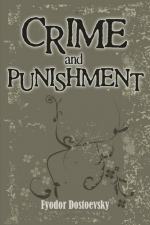|
This section contains 331 words (approx. 1 page at 400 words per page) |

|
Crime and Punishment Summary & Study Guide Description
Crime and Punishment Summary & Study Guide includes comprehensive information and analysis to help you understand the book. This study guide contains the following sections:
This detailed literature summary also contains Bibliography and a Free Quiz on Crime and Punishment by Fyodor Dostoevsky.
When the first installment of Crime and Punishment appeared in the Journal Russian Messenger in January of 1866, its debt-ridden author, Fyodor Mikhallovich Dostoyevsky, had not yet finished writing the novel. However, even before the entire work had appeared in serial form, the novel was a public success. Early Russian readers and critics recognized that, artistically and socially, Crime and Punishment was one of the most important novels of its time, and it was widely discussed.
On the surface, Crime and Punishment is the story of a murder, set in the city of St. Petersburg, then the Russian capital. It is not, however, a murder mystery: we know the murderer's Identity from the very beginning. Moreover, although Dostoyevsky depicts the crime and the environment in which It takes place with great realism, he is more interested in the psychology of the murderer than in the external specifics of the crime.
Like many of the great nineteenth-century novelists, Dostoyevsky often uses a series of incredible coincidences to move the plot forward. Nonetheless, the story takes on a compelling life of its own. Dostoyevsky's use of parable and of dream sequences is also original and remarkable. Furthermore, Dostoyevsky creates a gallery of memorable characters, including the proud and tormented ex-student Raskolnikov and his two murder victims; the drunken civil servant Marmeladov and his daughter, the meek prostitute Sonya, whose love helps to redeem Raskolnikov; Raskolnikov's devoted sister, mother, and best friend (Dunya, pulkheria Aleksandrovna, and Razhumikhin); Dunya's scheming suitor Luzhin and the sinister Svidrigailov; and the canny police investigator, Portiry Petrovich. Finally, beyond its powerful plot and colorful characters, Crime and Punishment is marked by its insightful treatment of several major themes. Among other things, the book is an expose of social conditions in nineteenth-century Russia, a satirical analysis of liberal and radical politics, and a religious call for redemption through suffering. As an intensely dramatic study of the nature of good and evil, it is commonly considered the quintessential Russian novel.
Read more from the Study Guide
|
This section contains 331 words (approx. 1 page at 400 words per page) |

|



